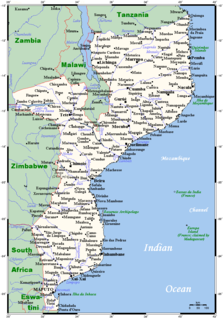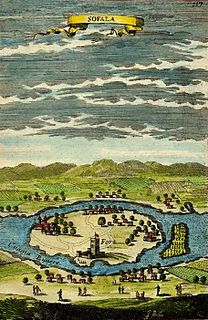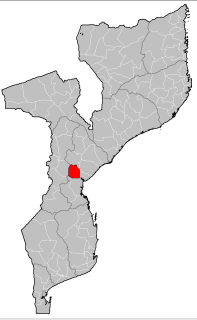Buzi River (Portuguese : Rio Búzi) is a river in Mozambique. Buzi flows eastward through the Manica and Sofala provinces of Mozambique. It then empties to the Mozambique Channel west of Beira, forming an estuary.
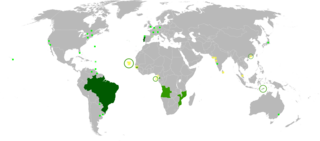
Portuguese is a Western Romance language originating in the Iberian Peninsula. It is the sole official language of Portugal, Brazil, Cape Verde, Guinea-Bissau, Mozambique, Angola, and São Tomé and Príncipe. It also has co-official language status in East Timor, Equatorial Guinea and Macau in China. As the result of expansion during colonial times, a cultural presence of Portuguese and Portuguese creole speakers are also found in Goa, Daman and Diu in India; in Batticaloa on the east coast of Sri Lanka; in the Indonesian island of Flores; in the Malacca state of Malaysia; and the ABC islands in the Caribbean where Papiamento is spoken, while Cape Verdean Creole is the most widely spoken Portuguese-based Creole. A Portuguese-speaking person or nation may be referred to as "Lusophone" in both English and Portuguese.

Mozambique, officially the Republic of Mozambique, is a country located in Southeast Africa bordered by the Indian Ocean to the east, Tanzania to the north, Malawi and Zambia to the northwest, Zimbabwe to the west, and Eswatini (Swaziland) and South Africa to the southwest. The sovereign state is separated from the Comoros, Mayotte and Madagascar by the Mozambique Channel to the east. The capital of Mozambique is Maputo while Matola is the largest city, being a suburb of Maputo.

Manica is a province of Mozambique. It has an area of 62,272 km² and a population of 1,412,245. The province is surrounded by Zimbabwe in the west, Tete Province in the northwest, Sofala Province in the east, Save River in the south, and Zambezi river in the northeast. Chimoio is the capital of the province. The highest mountain in Mozambique, Mount Binga, lies in this province near the border with Zimbabwe. The Manica province is divided into nine districts and 34 administrative regions.
The Buzi River is 250 kilometres (155 mi) long, with a drainage basin 31,000 square kilometres (12,000 sq mi) in size. Its mean annual discharge is 79 m³/s (2,790 cfs) at its mouth. [1]

A drainage basin is any area of land where precipitation collects and drains off into a common outlet, such as into a river, bay, or other body of water. The drainage basin includes all the surface water from rain runoff, snowmelt, and nearby streams that run downslope towards the shared outlet, as well as the groundwater underneath the earth's surface. Drainage basins connect into other drainage basins at lower elevations in a hierarchical pattern, with smaller sub-drainage basins, which in turn drain into another common outlet.
In hydrology, discharge is the volumetric flow rate of water that is transported through a given cross-sectional area. It includes any suspended solids (e.g. sediment), dissolved chemicals (e.g. CaCO3(aq)), or biologic material (e.g. diatoms) in addition to the water itself.
A cubic metre per second is a derived SI unit of volumetric flow rate equal to that of a stere or cube with sides of one metre in length exchanged or moving each second. It is popularly used for water flow, especially in rivers and streams, and fractions for HVAC values measuring air flow.
It often causes floods, frequently forming a floodplain together with the larger Pungwe River. Dombé and Búzi are situated on the banks of the river.
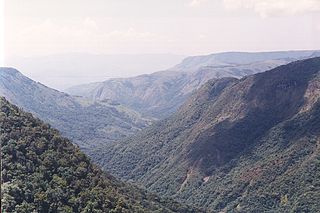
Pungwe River is a 400 km (250 mi) long river in Zimbabwe and Mozambique. It rises below Mount Nyangani in the Eastern Highlands of Zimbabwe and then flows southeasteastward through the Manica and Sofala provinces of Mozambique. the Pungwe enters southernmost portion of the Great Rift Valley, where it forms the southern boundary of Gorongosa National Park. The Urema River joins it, and the river follows the rift valley southward. Large seasonal wetlands form around the Pungwe and Urema rivers in the rift valley section. It empties into the Mozambique Channel at Beira, forming a large estuary. It is one of the major rivers of Mozambique and often causes floods.
Dombé is a town on the north bank of the Buzi River in Sussundenga District of Manica Province in central Mozambique dombe. During the Frelimo-Renamo struggle of the 70s to early 90s it was a strategic town where the FPLM maintained a heavy mechanized presence, since the Chimoio-Dombé-Espungabera road link which offered access to Zimbabwe, was repeatedly attacked and disrupted by insurgents. In 2010 the Dombé-Espungabera road was being rehabilitated, which was expected to improve the area's economic and tourism potential. The road is easier to travel during the dry months, from May to November, and then at about 50 km/h. Dombé has a fuel station but supplies can run out.
Buzi is a town on the banks of the Buzi River, in Buzi District, Sofala Province, Mozambique. In colonial times it was known as Nova Lusitânia or Nova Luzitânia.
